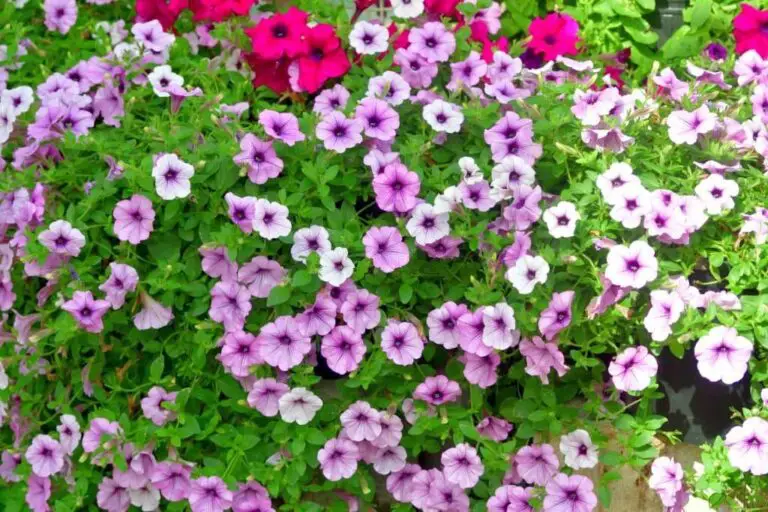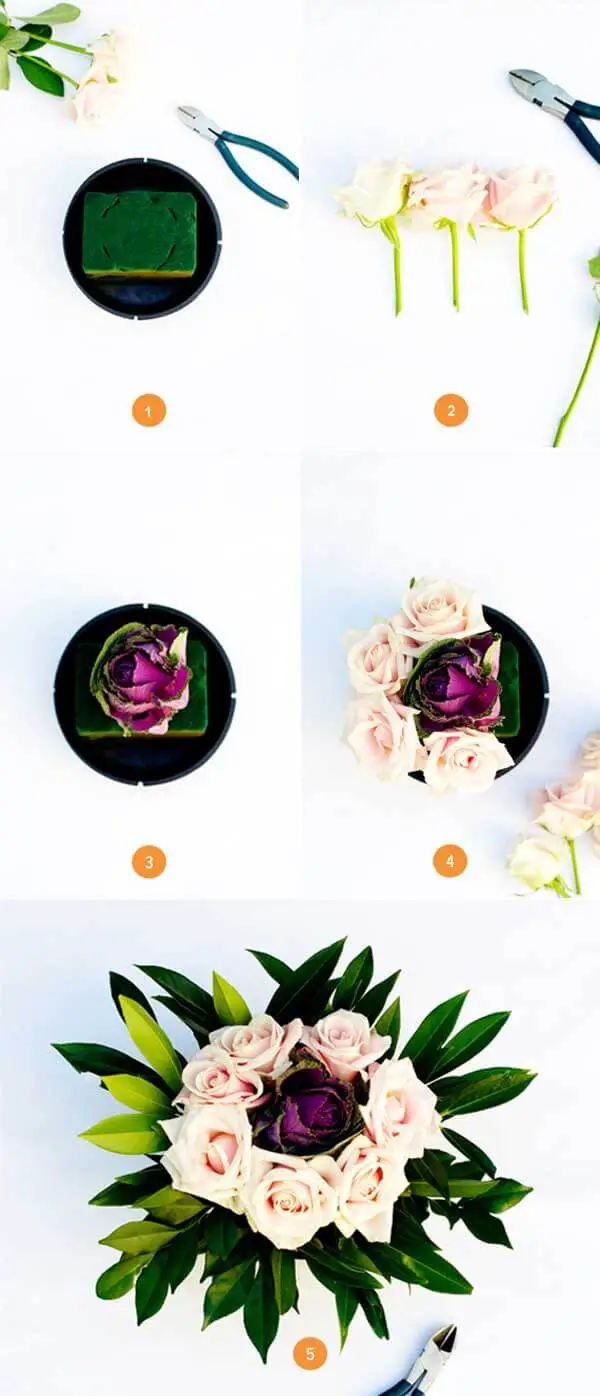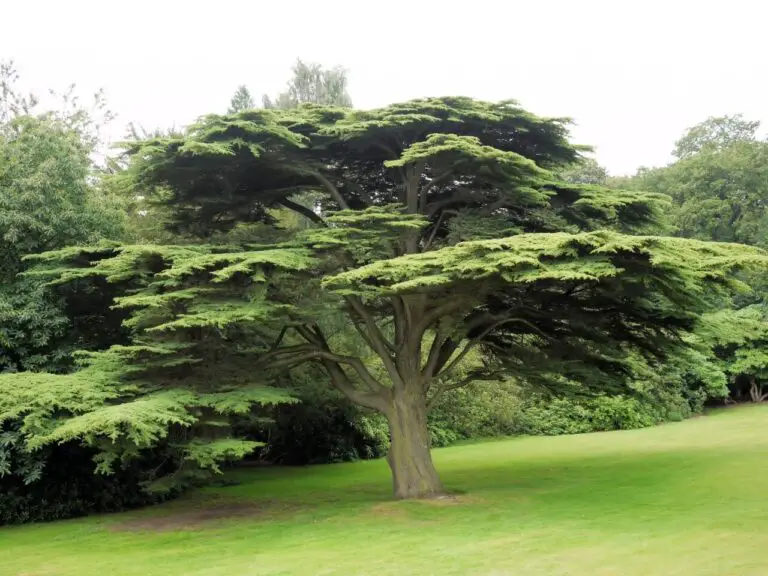How To Attract Butterflies To Your Garden With Flowers And Herbs
Butterflies bring a sense of vibrancy and vitality to any garden, playing a crucial role in maintaining the balance of nature. These delicate creatures not only add beauty with their striking wings but also contribute to the health of your local ecosystem by pollinating flowers and ensuring plant reproduction. By creating a butterfly-friendly garden, you’re not just enhancing its aesthetic appeal; you’re also supporting nature’s intricate web.
As butterflies flutter from bloom to bloom, they transfer pollen, allowing plants to thrive. This symbiotic relationship is vital for maintaining the health of your local ecosystem. In addition to their ecological importance, butterflies are a delight to behold, adding color and movement to your garden. By incorporating butterfly-friendly flowers, herbs, and sheltering options into your garden design, you can create a haven that attracts these beautiful creatures and supports their well-being.
Understanding Butterflies
Beyond their striking beauty, butterflies possess a rich biology and intricate ecological connections that warrant a deeper exploration. As we delve into the intricacies of these creatures’ life cycles and dietary habits, it becomes clear that their habitat plays a vital role in maintaining the delicate balance of our ecosystem.
Basic Biology of Butterflies
The life cycle of butterflies is a complex and fascinating process, comprising four distinct stages: egg, larva (caterpillar), pupa (chrysalis), and adult. Each stage presents its own set of needs and challenges, which are crucial for the overall survival and development of these magnificent creatures. During the egg stage, butterflies begin their life cycle by laying tiny eggs on plants. This marks the start of a remarkable transformation that will unfold over time.
As caterpillars, they enter the feeding stage where they consume plant leaves to fuel their growth and development. The larval stage is critical for the formation of their physical structure. In preparation for adulthood, butterflies undergo a transformative process inside a chrysalis (pupa). This metamorphosis allows them to emerge as adults, equipped with the necessary attributes to feed on nectar from flowers.
It’s remarkable that this dietary shift not only sustains the butterflies but also plays a vital role in pollination, thereby facilitating the reproduction of various plant species.
The Significance of Habitat for Butterflies
A butterfly’s very existence hinges on its habitat, which provides the fundamental necessities: sustenance, shelter, and mating grounds. Without a suitable environment, their prospects of survival dwindle, and so does their capacity to contribute to the ecosystem.
To thrive, butterflies rely on a diverse array of plants at various stages of their life cycle. Caterpillars, for instance, are often discerning eaters, preferring specific host plants for their leafy greens.
In contrast, adult butterflies seek out flowers teeming with nectar. This plant diversity not only supports butterfly populations but also fosters a rich biodiversity within the garden.
Creating a butterfly-friendly habitat necessitates consideration of both caterpillar and adult needs. It involves cultivating native species of flowers and shrubs, minimizing pesticide use, and providing secure spaces for butterflies to feed, rest, and breed.
By doing so, you’re not only providing butterflies with a haven but also enhancing the overall health and aesthetic appeal of your garden.
Planning Your Butterfly Garden
Crafting an oasis that beckons butterflies requires careful consideration of their unique needs. A thoughtful approach involves assessing the essential elements that draw these creatures in. This section delves into key factors such as location, size, and sunlight, as well as design principles that foster a butterfly-friendly haven.
Factors to Consider
When designing your butterfly haven, three fundamental elements come together in perfect harmony: location, size, and sunlight. Each of these factors plays a vital role in creating an environment that attracts and supports the beauty of butterflies.
The first and foremost consideration is location. Butterflies crave warm, sheltered spots away from strong winds. A spot with adequate protection allows them to feed comfortably while also providing a safe haven for laying eggs.
Size, on the other hand, is not necessarily a measure of success. A small yet well-designed area can be just as effective as a larger one. The key lies in thoughtful planning and arrangement. By creating a dense habitat that meets all their needs within a compact space, you can create a butterfly paradise.
Lastly, sunlight is essential for both butterflies and the plants they rely on. Most nectar-rich flowers require full sun to thrive and produce the sweet treat adult butterflies crave.
Aim for at least six hours of direct sunlight each day to create an ideal environment.
Design Principles for a Butterfly-Friendly Garden
Designing a butterfly-friendly garden is a thoughtful approach that goes beyond simply planting flowers. It’s about crafting an ecosystem that supports the entire lifecycle of these mesmerizing creatures. By incorporating a diverse range of plants, you can cater to different species at various stages of their life cycle. Native plants are particularly effective in providing optimal food sources for local butterfly populations.
To create a thriving haven, plan your garden with continuous bloom in mind – from early spring to late fall, something should always be in full flower. This perpetual supply of nectar and pollen will attract and sustain butterflies throughout the seasons.
Layered planting is another crucial consideration. By mixing plant heights and types, you can mimic natural habitats and offer ample feeding and resting spots for butterflies.
In addition to these design elements, it’s essential to adopt a pesticide-free approach. These chemicals can harm butterflies and other beneficial insects, so opt for natural pest control methods instead.
Finally, don’t forget to include a shallow water source – like a birdbath with stones – that allows butterflies to land and drink. This simple feature will provide them with a vital spot to cool off and replenish their energy.
Best Flowers for Attracting Butterflies
Transforming your garden into a haven for butterflies can be achieved by selecting nectar-rich flowers that cater to their distinct tastes. To create an ideal environment, it’s essential to choose a mix of annuals and perennials that are known to attract these magnificent creatures. Furthermore, incorporating native flowers into your garden design is crucial, as they provide the perfect blend of sustenance and shelter for butterflies.
Overview of Nectar-Rich Flowers
Butterflies are drawn to flowers that offer a rich source of nectar. These blooms not only serve as a sustenance source but also provide a sheltered spot for butterflies to rest and warm up in the sun’s gentle rays. To create an inviting habitat, choose a mix of flowering plants with varying bloom times, ensuring a consistent food supply throughout the growing season.
Annuals: Zinnias, Marigolds, and Sunflowers
While annual plants only thrive for a single growing season, they offer a plethora of benefits. They are prolific bloomers, producing vibrant colors and abundant nectar that attracts butterflies. In fact, certain annuals are particularly beloved by these delicate creatures. Here’s a look at three annuals that butterflies simply adore: Zinnias, with their bright, multi-colored blooms, provide an ideal environment for easy nectar access.
The deep flowers offer a perfect landing spot and abundant sweet treats. Marigolds, boasting gold, orange, and yellow hues, impress with their intense colors and strong fragrance. These vibrant flowers are a hit with butterflies, who can’t resist their allure. Sunflowers, with their large, yellow petals and dark centers, provide an expansive landing platform and plenty of nectar to fuel the butterfly’s activities.
Perennials: Coneflowers, Lavender, and Black-eyed Susans
In any butterfly garden, perennial plants are a must-have due to their ability to return year after year. These plants provide a multitude of benefits for butterflies, making them an essential component of a thriving habitat. Some of the most popular perennials that attract butterflies include coneflowers, which boast pink, purple, and white flowers with prominent centers. Butterflies are drawn to these flowers because they offer easy access to nectar and pollen.
Lavender is another perennial that’s hard to resist, its fragrant, purple blooms emitting a strong scent that attracts butterflies seeking rich nectar. Black-eyed Susans, with their bright yellow petals and dark centers, also provide an abundance of nectar and continuous blooming, making them a butterfly magnet.
Importance of Native Flowers in Supporting Local Butterfly Populations
Native flowers have a profound impact on local butterfly populations, and by incorporating them into your garden, you’re supporting their survival. These plants have evolved alongside butterflies, catering to their unique needs in ways that exotic plants cannot. As an added bonus, native species require less maintenance and thrive better than non-native alternatives. One of the key advantages of using native flowers is their adaptability to local climate and soil conditions.
This makes them more resilient and easier to care for, reducing the need for constant pruning or fertilization. Butterfly support isn’t the only benefit you’ll reap from planting natives. You’re also contributing to the overall health of your ecosystem by providing habitat and food for a diverse range of wildlife. By creating a haven for these creatures, you’re helping to promote biodiversity and create a more dynamic garden environment. So, which plants are ideal for attracting butterflies?
The good news is that there’s no single ‘magic’ plant that can’t resist their charms – instead, there are many highly desirable species that will draw in different butterfly varieties. Here are ten of the best butterfly-attracting plants to get you started:
#1. Azaleas
#2. Honeysuckles

Honeysuckles are a diverse group of flowering plants renowned for their sweet fragrance and tubular blooms that come in a range of colors including white, yellow, pink, and red. Belonging to the Lonicera genus, they comprise both shrub-like and climbing varieties, making them versatile options for various garden designs.
One of the most notable attributes of honeysuckles is their ability to attract pollinators like bees, butterflies, and hummingbirds with their nectar-rich flowers.
These plants thrive in full sun to partial shade and can adapt to a range of soil types, though they generally prefer well-drained conditions.
Climbing varieties are particularly useful for covering trellises, fences, and other structures, adding both visual appeal and a delightful aroma to gardens. While most honeysuckles are relatively easy to grow and maintain, some species can be invasive in certain areas, so it’s essential to choose cultivars suited to your local environment.
With proper selection and care, honeysuckles can be a beautiful and fragrant addition to any outdoor space.
#3. Milkweed
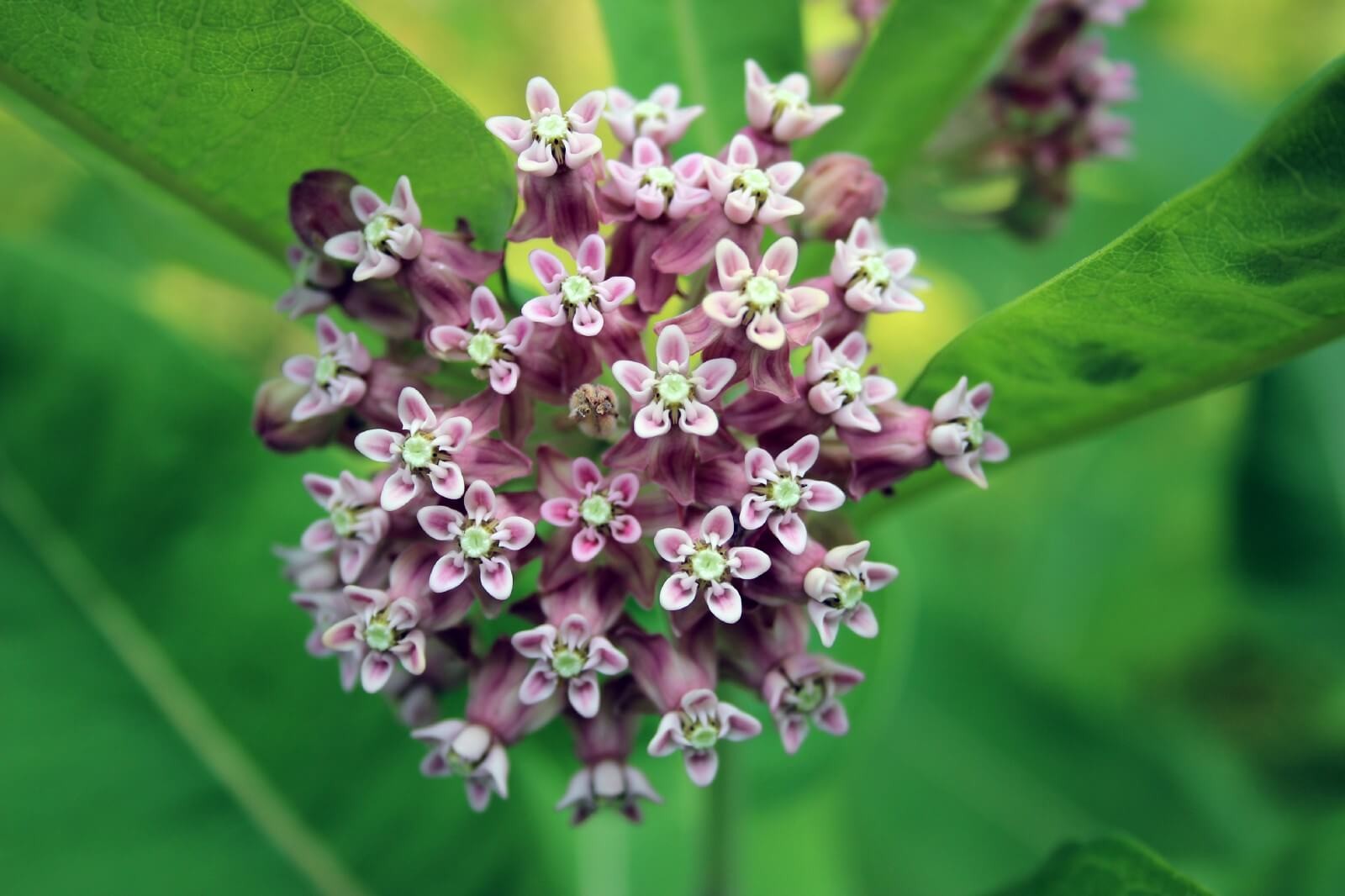
Milkweed plants are a crucial component of monarch butterfly ecology, serving as the primary food source for larvae. This unique relationship is rooted in the plants’ ability to produce milky sap containing alkaloids and cardenolides, which provide monarch caterpillars with a defense mechanism against predators. The intricate flowers of milkweed, available in shades of pink, orange, white, and green, not only support monarchs but also add visual appeal to gardens.
Milkweed is an easy-to-grow and low-maintenance option for gardens, thriving in full sun and well-drained soil. Once established, it can tolerate drought, making it a sustainable choice for gardening practices. Beyond supporting monarchs, milkweed attracts a range of pollinators, including bees and other butterflies, contributing to local ecosystem health.
Incorporating milkweed into community spaces or personal gardens not only aids monarch populations, which have been declining due to habitat loss and environmental pressures, but also enhances biodiversity and visual appeal in the area.
#4. Asters
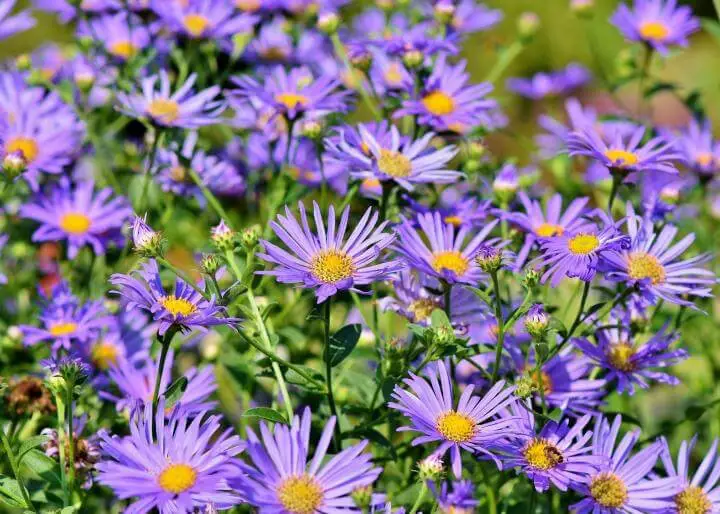
Asters, a diverse group of flowering plants, are renowned for their star-shaped blooms that come in a kaleidoscope of colors including purple, blue, pink, white, and red. These perennial plants, belonging to the Aster genus, are cherished for their extended late-season blooming period, typically occurring from late summer into fall when many other garden flowers have wilted.
This unique trait makes them an indispensable addition to any garden, offering a burst of color and visual interest during a time when other plants begin to decline. Asters are relatively simple to cultivate and can flourish in various conditions, although they prefer well-drained soil and a location that receives partial sun or shade.
Notably, these flowers are renowned for attracting an array of wildlife, including bees, butterflies, and other pollinators, making them an excellent choice for those seeking to create a more biodiverse and eco-friendly garden. The vibrant blooms and prolonged flowering period of asters not only enhance the aesthetic appeal of gardens but also provide a vital nectar source for pollinators preparing for migration or overwintering.
Their adaptability and low maintenance requirements make them a favored choice among gardeners seeking to elevate their outdoor spaces with reliable, attractive, and easy-to-care-for plants.
#5. Red clover
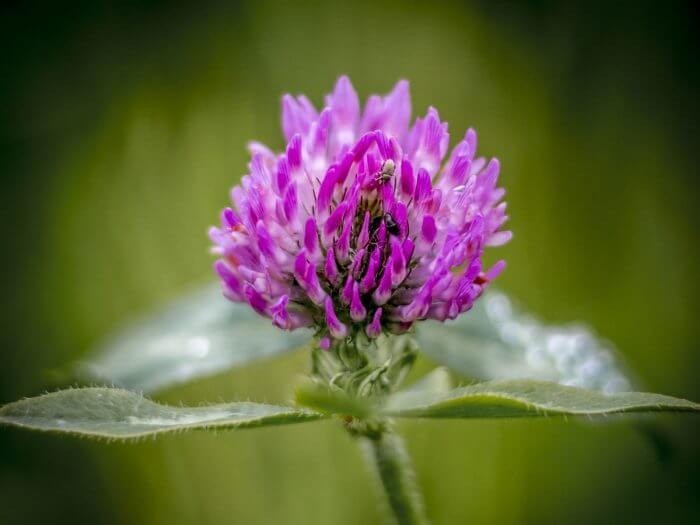
Red clover, Trifolium pratense, is a perennial herbaceous plant renowned for its striking pink to red blooms. This legume species thrives in meadows, fields, and grassy areas across Europe, Western Asia, and northwest Africa, having been naturalized in many other regions. Its appeal extends beyond aesthetics, as it’s highly valued in agriculture for its role as a cover crop that enriches soil health by fixing nitrogen, an essential nutrient for plants.
This plant’s utility is further underscored by its medicinal properties, which have led to its traditional use in herbal medicine to treat various conditions. The flowers and leaves of red clover are rich in nutrients and isoflavones, compounds that can mimic estrogen in the body, making it a popular ingredient in remedies aimed at alleviating menopause symptoms and supporting bone health.
In gardens and landscapes, red clover serves as an effective groundcover or component of wildflower meadows, attracting bees, butterflies, and other pollinators with its nectar- rich flowers. Its adaptability to various soil types and conditions makes it a low-maintenance plant that’s easy to grow, contributing to its enduring popularity among gardeners seeking to introduce both beauty and biodiversity to their outdoor spaces.
#6. Zinnias
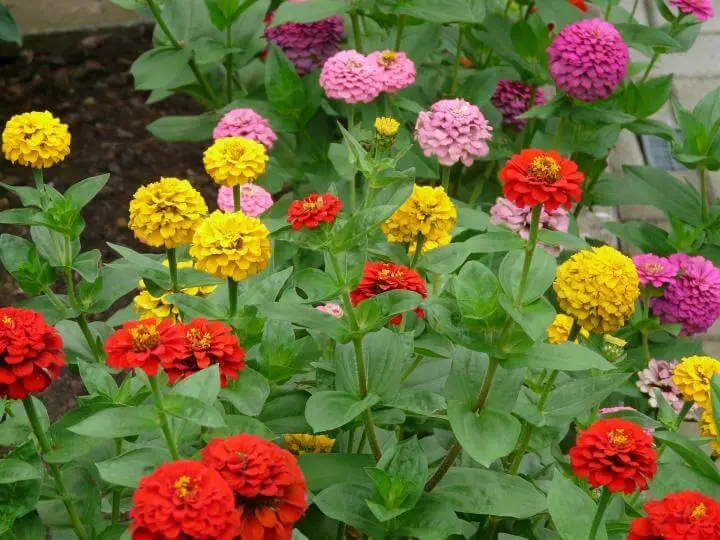
Zinnias burst forth with vibrant color, showcasing a kaleidoscope of hues, sizes, and shapes that captivate gardeners worldwide. Their effortless cultivation and affinity for warm temperatures make them an ideal choice for adding a pop of color to gardens during the summer and fall seasons. As a pollinator-friendly option, zinnias attract a diverse range of visitors, including butterflies and bees, making them a stellar addition to any garden focused on supporting these essential creatures.
With varieties spanning from compact dwarf forms perfect for container gardening to statuesque tall varieties ideal for dramatic backdrops or cut flower arrangements, there’s a zinnia to suit every gardener’s style. Their rugged resilience and low maintenance requirements for water and care render them an excellent choice for both novice and seasoned gardeners seeking long-lasting blooms that require minimal fuss.
#7. Daisies
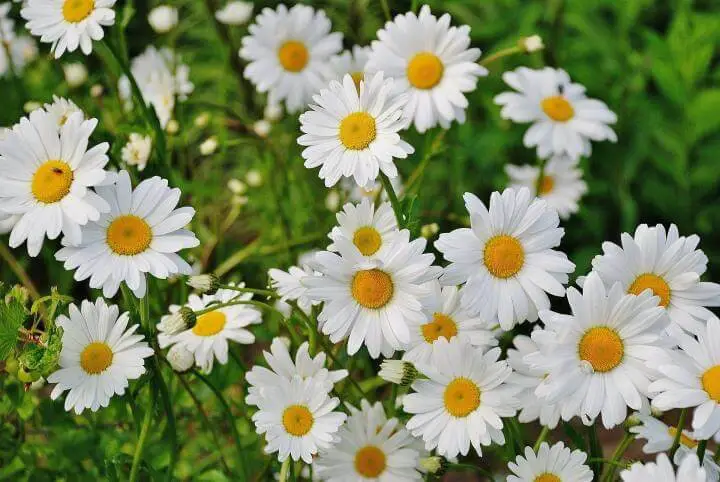
Daisies are a symbol of simplicity and charm, characterized by their classic white petals encircling a vibrant yellow center. As perennial plants, they belong to a vast family that encompasses numerous species, each boasting its own distinct characteristics. The most widely recognized variety is perhaps the common daisy (Bellis perennis), renowned for its iconic appearance. Beyond their aesthetic appeal, daisies are also imbued with symbolic significance, representing innocence and purity.
As such, they’re a popular choice in gardens and floral arrangements. These adaptable plants thrive in environments ranging from full sun to partial shade, and demonstrate remarkable resilience by tolerating a wide range of soil conditions. In addition to their visual appeal, daisies play a crucial role in attracting beneficial insects like bees and butterflies, thereby contributing to the overall biodiversity of the garden ecosystem.
Their low maintenance requirements and cheerful appearance have made them a beloved addition to landscapes and gardens worldwide.
#8. Cosmos
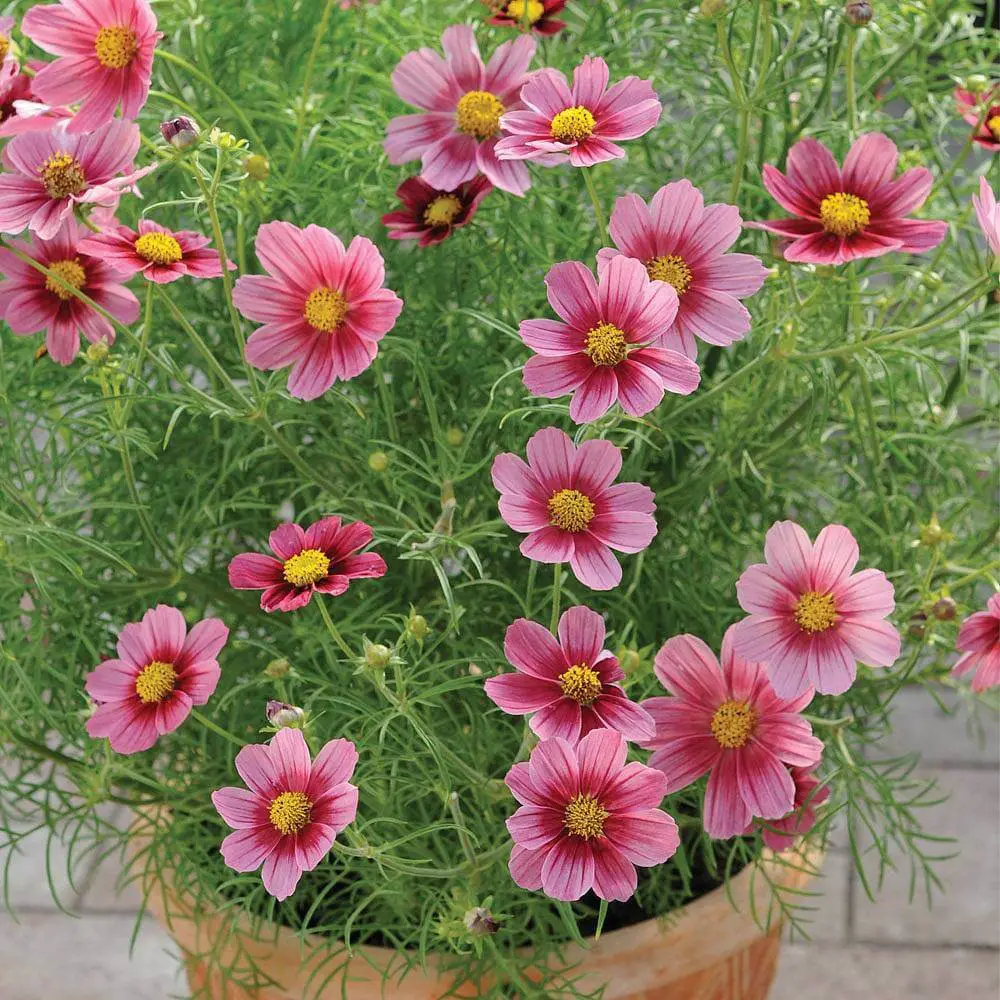
Cosmos are an annual delight, boasting vibrant, daisy-like blooms and delicate, feathery foliage that’s reminiscent of their Mexican origins. Their popularity stems from the effortless way they can brighten up any garden setting with their kaleidoscope of colors, including pink, white, red, and orange.
One of the most impressive aspects of cosmos is their ability to attract butterflies and other pollinators, making them a haven for local wildlife.
They’re also incredibly easy to care for, thriving in well-drained soil and full sun, which makes them an ideal choice for gardeners of all skill levels.
As they grow, cosmos can reach heights of up to six feet, depending on the variety, making them a stunning addition to any garden or bouquet. And when their blooming period stretches from summer through the first frost, you’ll be treated to a non-stop display of beauty throughout the growing season.
#9. Hibiscus
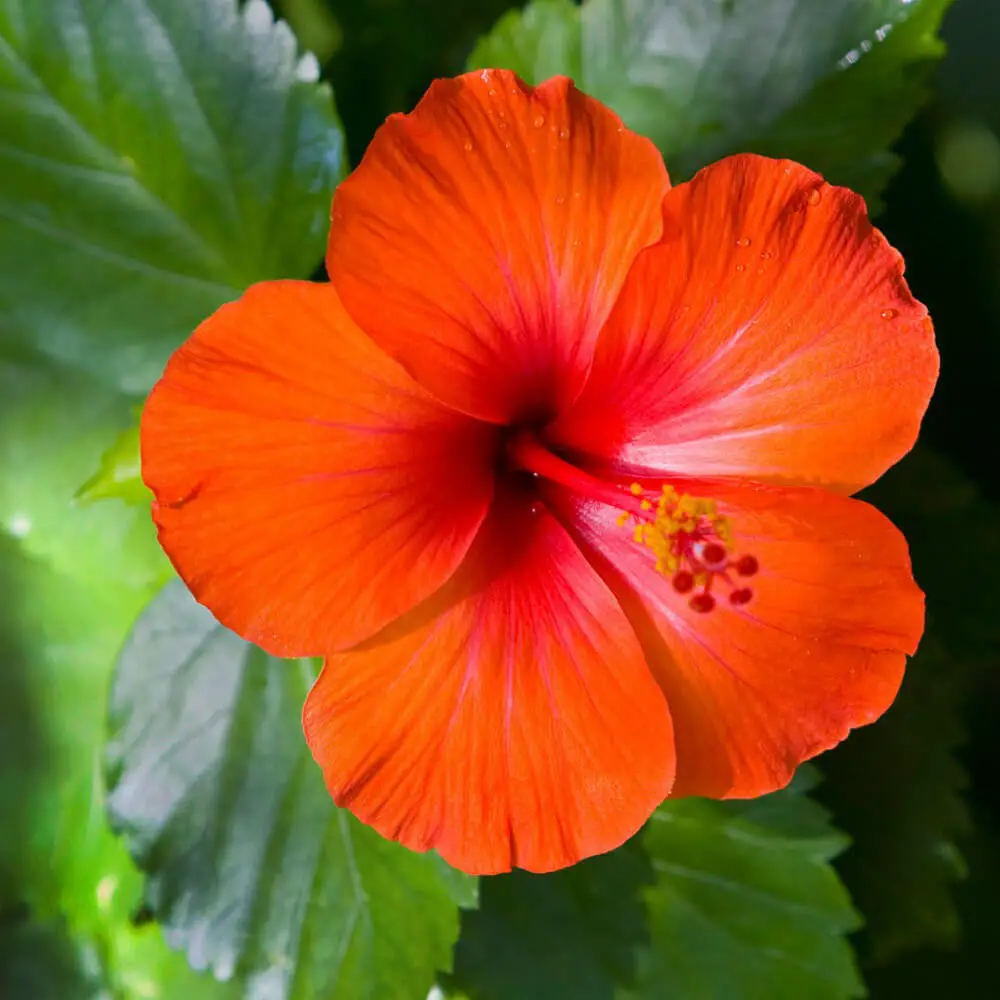
Hibiscus is a vibrant and diverse genus of flowering plants that can bring a touch of tropical elegance to any garden. Characterized by their large, showy blooms, these flowers display an array of colors including red, pink, orange, yellow, and white, often featuring a striking central contrast.
These stunning plants thrive in both tropical and temperate climates, encompassing annual and perennial species that prefer full sun and well-drained soil.
In their natural habitat, they flourish in conditions reminiscent of the tropical environments from which they originate.
Beyond their ornamental appeal, some hibiscus species are also valued for their culinary and medicinal properties. The plants’ flavor profiles have been leveraged in teas and dishes, while their potential health benefits continue to be explored.
Additionally, these flowers serve as a vital source of sustenance for various pollinators like bees and hummingbirds, making them an excellent addition to any garden seeking to support local wildlife.
#10. Orchids
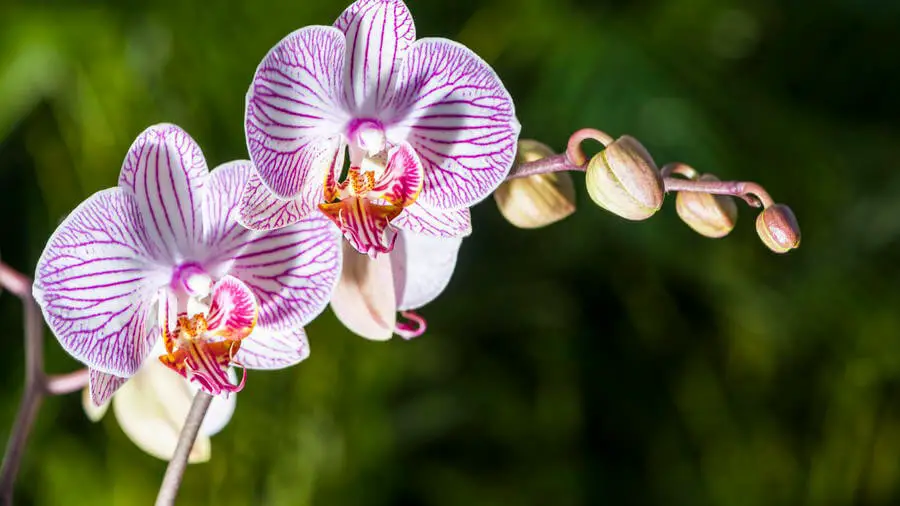
Orchids boast an unparalleled reputation for being one of the most extensive and varied families of flowering plants. Their exquisite beauty is matched only by their incredible diversity in color, shape, and size. From vibrant, attention-grabbing hues to delicate, subtle tones, each species showcases its unique patterns and fragrances.
These sophisticated flowers can be found in a wide range of environments, from lush rainforests to arid deserts, with many epiphytes thriving on tree trunks rather than soil. Their intricate flower structures have evolved to attract specific pollinators in their native habitats, further adding to their allure.
Caring for orchids can be a challenging yet rewarding experience, as the requirements for light, water, and temperature vary significantly among species.
However, their long-lasting blooms make them a favorite among enthusiasts and a stunning addition to any indoor garden, offering a unique opportunity to appreciate their beauty up close.
Incorporating Herbs in Your Butterfly Garden
Butterflies and other pollinators are drawn to gardens that incorporate herbs in addition to their culinary uses. These plants offer a unique dual benefit: providing essential nectar for adult butterflies while serving as host plants for their larvae, supporting the entire life cycle. By planting herbs in your garden, you’re not only enhancing its aesthetic appeal but also creating a haven for these vital creatures.
Let’s explore the advantages of incorporating herbs into butterfly gardens, highlighting recommended species and offering practical tips for cultivation.
Benefits of Herbs for Butterflies and Other Pollinators
Butterflies are drawn to herbs for their vibrant flowers and enticing scents, which offer a rich source of nectar for sustenance. This bounty is particularly important for adult butterflies and other pollinators like bees and hummingbirds, as it provides the necessary energy for survival. Beyond their blooms, certain herb varieties also offer a vital food source for caterpillars, playing a pivotal role in the butterfly lifecycle’s progression from egg to adult.
Recommended Herbs: Fennel, Dill, Parsley, and Mint
Butterflies are drawn to certain herbs that offer them specific benefits. For instance, fennel and dill provide host plants for the Black Swallowtail butterfly species, allowing them to lay their eggs on these plants and feed their caterpillars on the leaves. Parsley, on the other hand, serves as a safe haven for egg-laying and offers food for growing larvae.
Mint is particularly attractive to butterflies, offering nectar-rich flowers that serve as a vital energy source and its dense foliage providing cover and shelter for various pollinators. The combination of these herbs’ unique features makes them highly sought after by butterfly species, highlighting the importance of incorporating these plants into one’s garden or outdoor space.
Tips for Planting and Caring for These Herbs
When cultivating herbs in a butterfly garden, several factors come into play to ensure optimal growth and attraction for these beautiful creatures. Consider the following key considerations:Firstly, sunlight plays a crucial role. Aim for a location that receives at least six hours of direct sunlight daily, as this will benefit both the butterflies and the herbs. Most herbs and butterflies thrive in full sun, making it an essential factor to consider.
Next, focus on soil quality and watering habits. Ensure the soil is well-draining yet retains moisture, as herbs can’t tolerate prolonged dryness or waterlogging. A delicate balance between these two extremes is key to supporting healthy herb growth. In terms of spacing and grouping, plant your herbs in clusters to create an abundant source of nectar and leaves. This not only benefits the butterflies but also makes it easier for them to locate the plants.
A well-designed herb garden can be a haven for these delightful creatures. Finally, when it comes to pest control, adopt natural methods that prioritize butterfly safety. Avoid using pesticides at all costs, as they can harm or kill these delicate insects. Instead, rely on herbs’ natural resistance to pests and the presence of natural predators to maintain a balanced ecosystem.
#1. Nettles
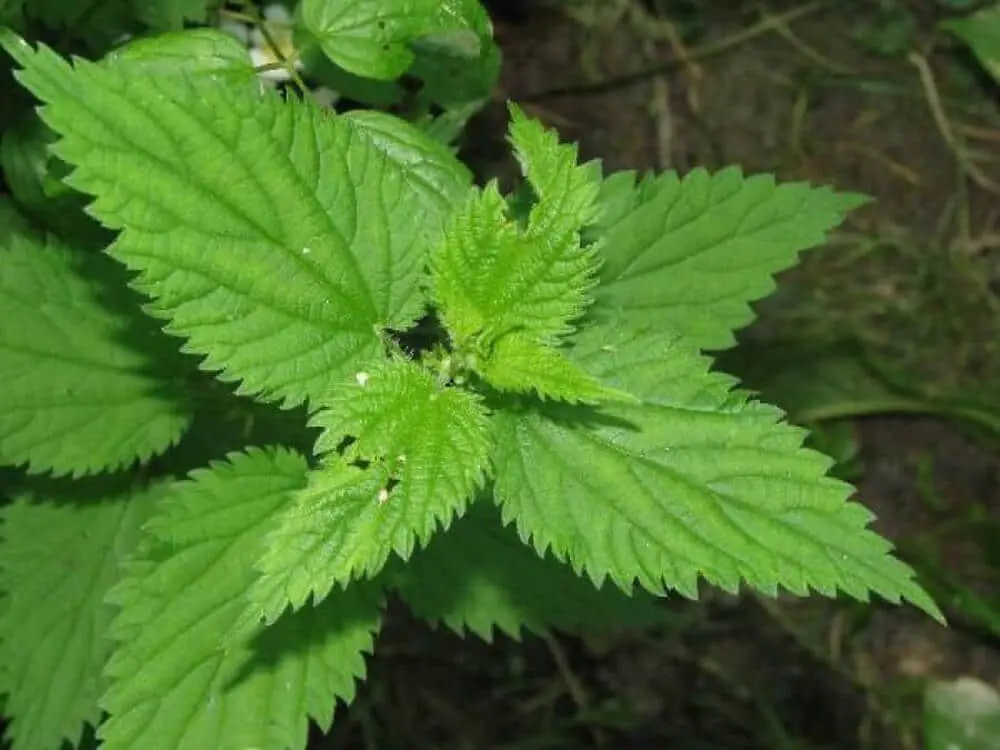
Perennial plants known as Urtica dioica, or nettles, possess a distinctive feature – stinging hairs on their leaves and stems that can cause skin irritation upon contact. This reputation notwithstanding, nettles are highly esteemed for their nutritional value and medicinal properties, boasting an impressive array of vitamins, minerals, and antioxidants. Furthermore, they play a crucial role as host plants for several butterfly species, serving as a vital food source for their larvae.
#2. Passionflower
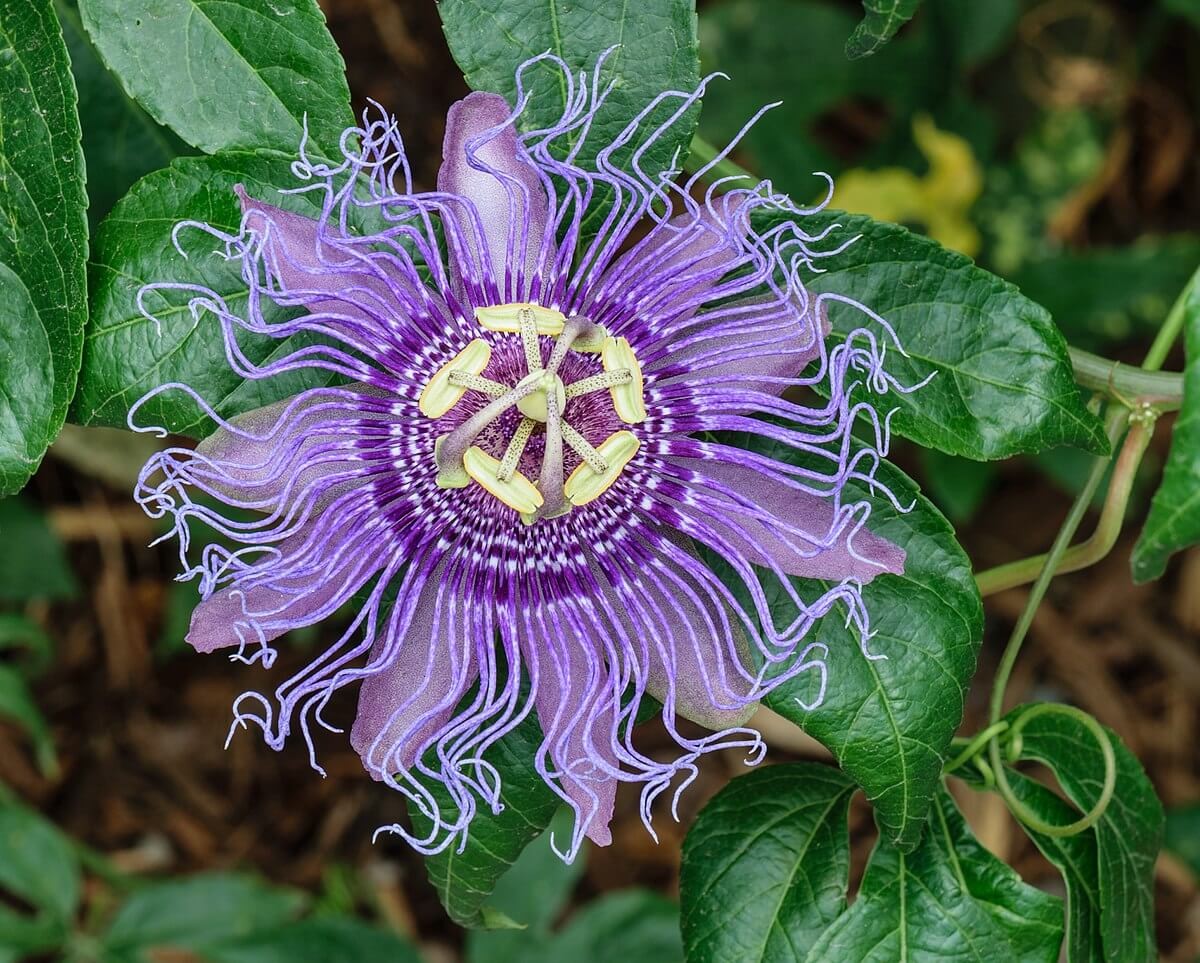
The Passionflower, or Passiflora, is a prolific genus comprising over 500 species, distinguished by its intricate, exotic blooms and climbing vine growth. Its ornate flowers, characterized by a distinctive structure and vivid colors, make it a standout in gardens. Moreover, the plant’s medicinal properties have been harnessed to develop herbal remedies that promote relaxation, alleviate anxiety, and aid sleep quality.
As an added bonus, these plants serve as magnets for pollinators like bees and butterflies, rendering them a valuable asset to any outdoor setting.
#3. Mint
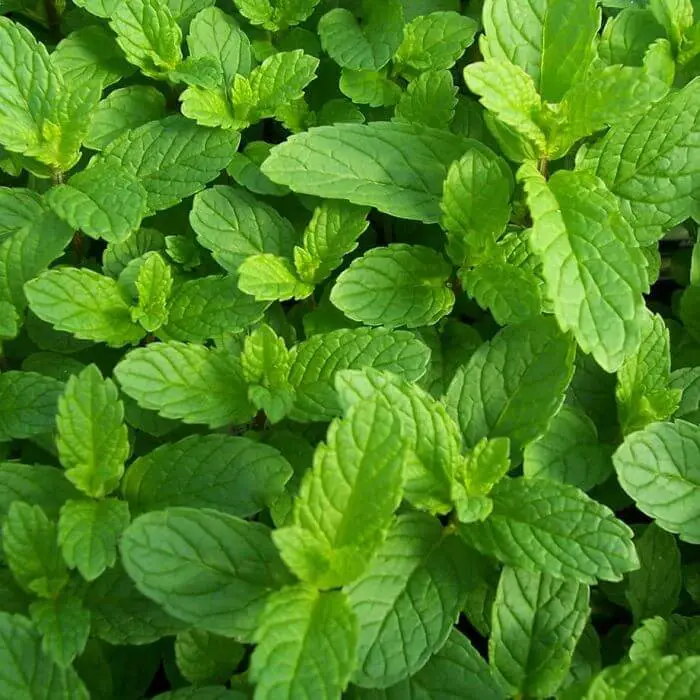
Mint, a widely cultivated herb within the Mentha genus, is prized for its invigorating aroma and adaptability in culinary applications. This rapid-growing plant is simple to cultivate, tolerating diverse environmental conditions while thriving in moist soil with partial shade. Notably, mint’s pungent fragrance also serves as an effective deterrent against pests, while its blooms attract beneficial pollinators, enriching the surrounding garden environment.
#4. Meadowsweet
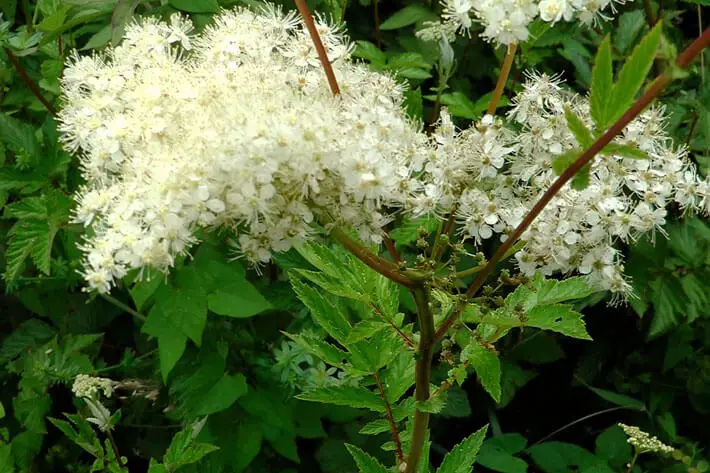
Meadowsweet (Filipendula ulmaria) is a perennial herb that boasts a reputation for its captivating clusters of creamy-white blooms, emitting a sweet fragrance. This versatile plant has a long history of use as a natural remedy to alleviate pain and fever. Meadowsweet thrives in damp environments, such as meadows and stream banks, where it can bask in partial sunlight and moist soil.
Beyond its aesthetically pleasing appearance, the flowers also play a crucial role in attracting an array of pollinators, making this plant a valuable asset for biodiversity.
#5. Dill
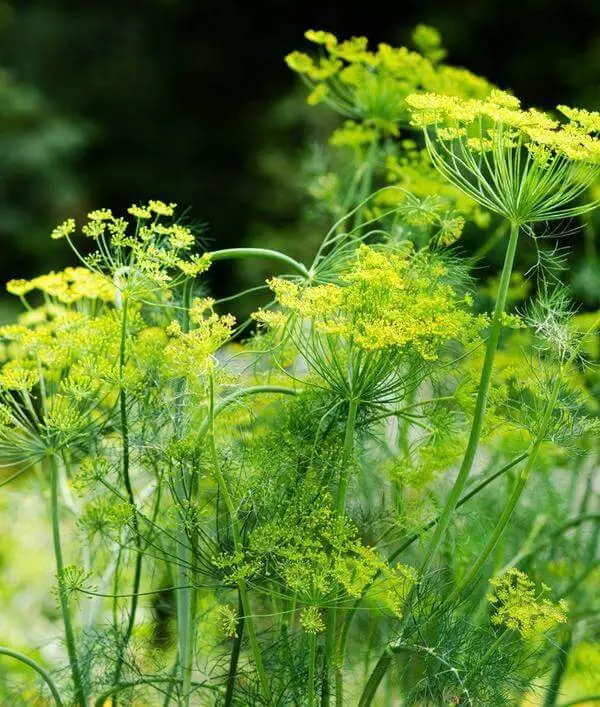
Dill (Anethum graveolens) is an annual herb characterized by its lacy, feathery foliage and showy, umbrella-shaped blooms that burst forth in a vibrant shade of yellow. While it’s perhaps most renowned for its pungent flavor, which adds depth to pickling endeavors, this versatile herb has much more to offer.
Notably, dill is an ideal host plant for the larvae of various butterfly species, including the majestic Black Swallowtail, and its fragrant blooms attract a diverse array of pollinators, making it a valuable addition to any garden or culinary endeavor.
#6. Anise
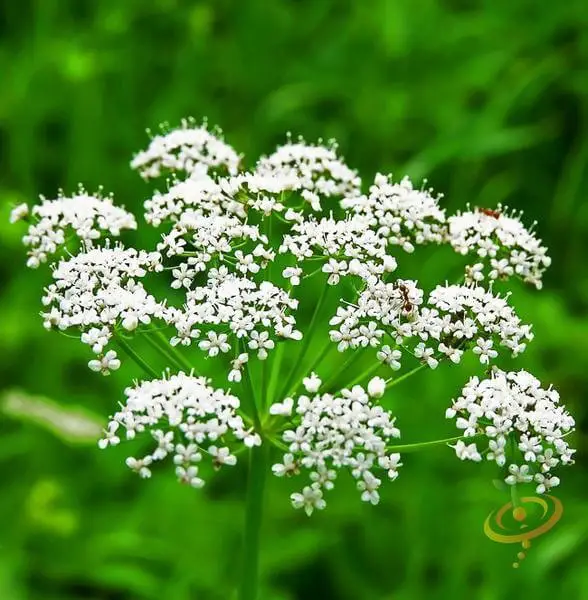
Flowering beneath the warmth of the sun, anise (Pimpinella anisum) is a plant that yields seeds imbued with a distinctive sweetness reminiscent of licorice. This versatile herb is frequently employed in both sweet and savory culinary applications, as well as the production of liqueurs. Its adaptability extends beyond the realm of cooking, as it also fosters beneficial insects to visit the garden, thereby promoting pollination and natural pest management.
#7. Fennel
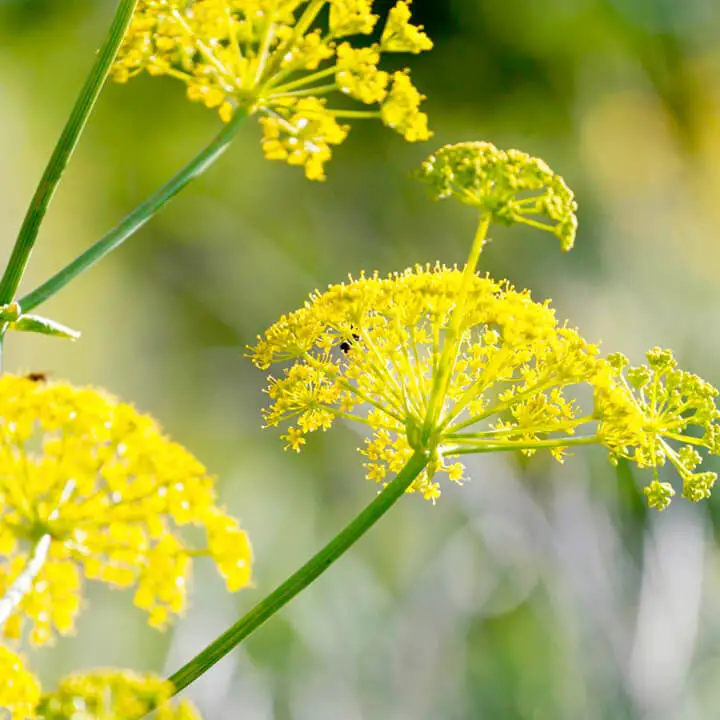
Foeniculum vulgare, commonly known as fennel, boasts an intoxicating aroma and delectable flavor profile. Characterized by its delicate feathery foliage and bright yellow blooms, this versatile herb is a staple in numerous culinary traditions, including Italian and Indian cuisine. Fennel thrives in full-sun environments with fertile, well-drained soil conditions.
Notably, it serves as a valuable attractant for pollinators, particularly the Anise Swallowtail butterfly, which relies on fennel as a host plant for its larvae.
#8. Parsley
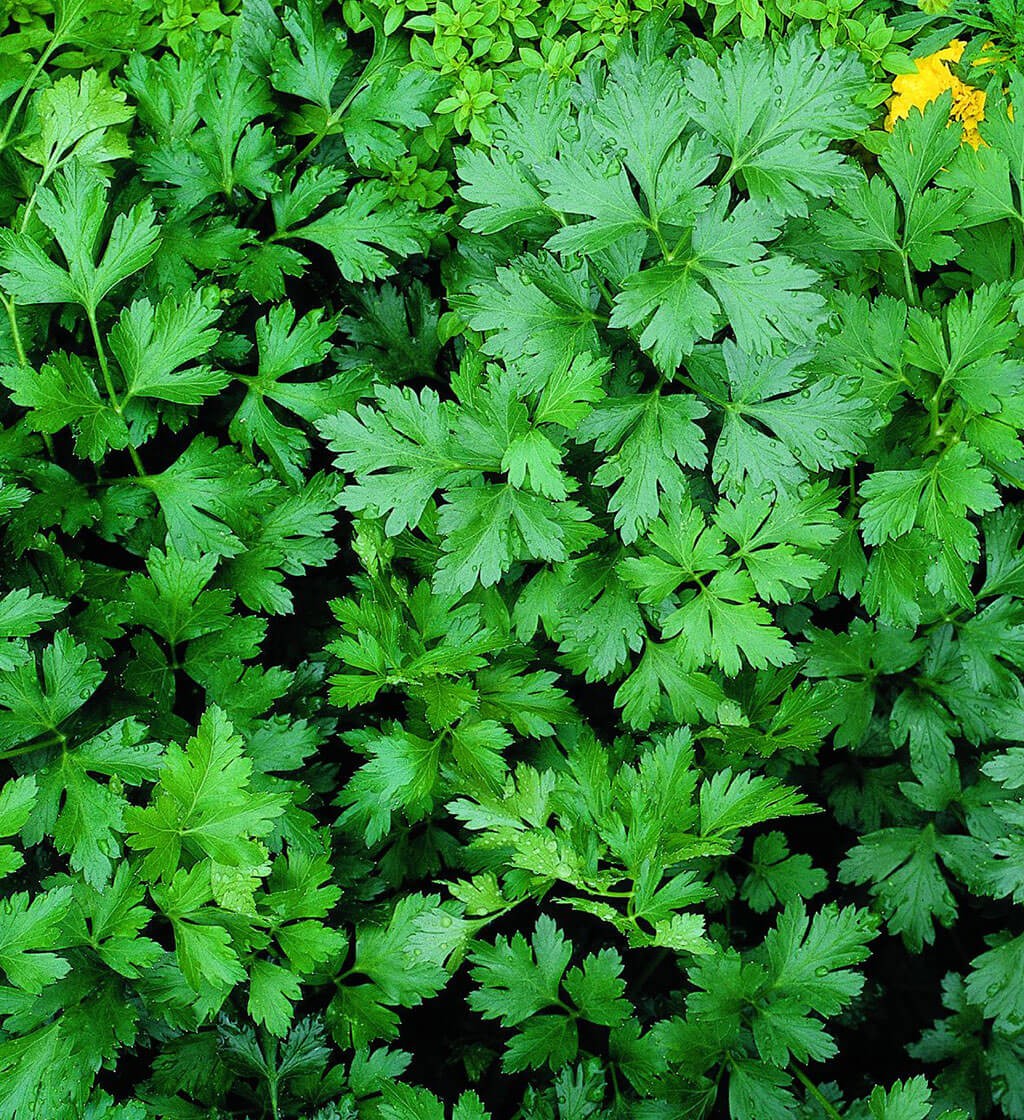
In many kitchens, parsley (Petroselinum crispum) holds a special place as a versatile and flavorful herb. Not only does it add a fresh, green taste to various dishes, but its curly leaves also make it a popular choice for garnishing plates. As a biennial plant, parsley thrives in well-lit or partially shaded areas with rich, moist soil that fosters healthy growth.
Beyond its culinary appeal, parsley serves as an attractive haven for beneficial insects, including the Black Swallowtail butterfly, which lays its eggs on the plant’s leaves.
#9. Prickly ash
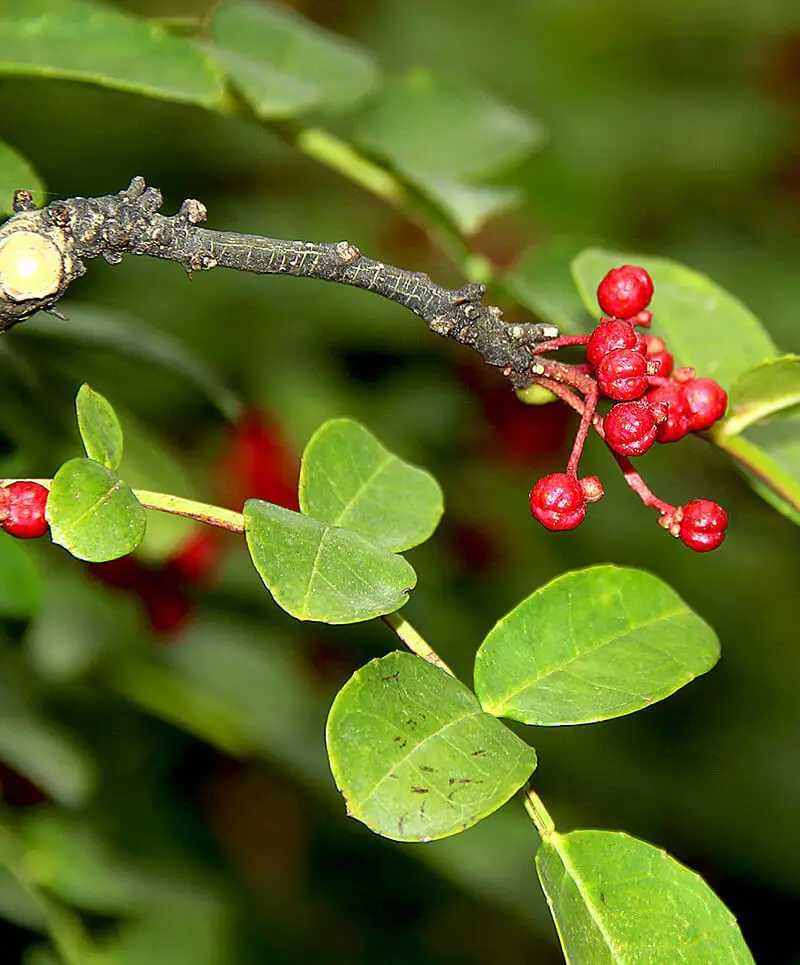
Prickly Ash (Zanthoxylum americanum) is a deciduous shrub or small tree that stands out with its distinctive, sharply spined bark and fragrant leaves. This versatile plant has been utilized in both traditional medicine and cooking, despite its potent, peppery flavor profile.
In terms of growing conditions, Prickly Ash thrives in well-drained soil and can even tolerate partial shade.
Notably, it also serves as a vital host plant for the Giant Swallowtail butterfly, providing a nutrient-rich food source for the larvae.
#10. Milkweed

The relationship between milkweed and Monarch butterflies is one of mutual dependence, with the plant serving as a vital source of sustenance for both the caterpillars’ food supply and the adult butterflies’ egg-laying habits. Asclepias, the genus from which milkweed primarily originates, provides a unique environment where monarchs can thrive.
In addition to its importance in supporting butterfly populations, milkweed’s vibrant flowers also attract a variety of pollinators, making it a crucial component of any garden seeking to foster biodiversity. Its adaptability to full sun and well-drained soil means that it not only adds beauty to the landscape but also contributes to the overall health and well-being of monarch populations.
How to Successfully Attract Butterflies
To entice butterflies to your garden, it’s essential to provide a welcoming environment through the presence of host herbs or flowers. Aim for a diverse selection by planting two or three varieties. The absence of these plants will significantly hinder the creation of a butterfly-friendly habitat. If you prefer, designate a secluded area or corner for these plants, allowing you to coexist with the larvae without visual disruption.
For specific species, consider milkweed for monarchs, parsley for swallowtail butterflies, and meadowsweet for spring azure butterflies. Be sure to research which species can thrive in your garden’s climate zone.
Creating a Supportive Environment
To create a haven for butterflies in your garden, it’s crucial to go beyond just offering sustenance. A welcoming environment is comprised of three fundamental elements: accessible water sources, sheltering options, and a dedication to refraining from pesticides. Each component plays a vital role in establishing a butterfly-friendly habitat. The importance of providing these essential resources will be explored in further detail.
The Role of Water Sources for Butterflies
Butterflies require water to survive, but they don’t necessarily drink from open water sources. Instead, they prefer to sip water and absorb essential minerals and salts from mud puddles or damp soil. This unique behavior is known as ‘puddling,’ allowing them to replenish their bodily fluids and maintain overall health.
Butterflies can also benefit from alternative hydration sources, such as shallow dishes filled with sand and water or damp sponges placed in the garden.
These man-made structures mimic natural puddling environments, providing a safe and accessible way for butterflies to quench their thirst without the risk of drowning in deeper water.
Incorporating these simple yet effective hydration stations into your garden can make a significant difference in supporting local butterfly populations.
Sheltering Options: Shrubs, Trees, and Butterfly Houses
Butterflies require shelter to evade predators, recharge, and sometimes weather the winter months. Your garden can provide natural sanctuaries in the form of shrubs and trees, as well as artificial habitats like butterfly houses.
These options offer distinct benefits: shrubs serve as natural protection and resting spots when planted in clusters; trees provide elevated views and cooling shade, particularly if you incorporate native species that support local wildlife; while butterfly houses offer a safe haven during inclement weather, ideally situated in quiet, sheltered areas of the garden.
By planting a diverse array of shrubs and trees, you not only create havens for butterflies but also boost your garden’s biodiversity, attracting a variety of beneficial insects and animals.
Avoiding Pesticides and Fostering a Natural Ecosystem
When it comes to creating a haven for butterflies in your garden, it’s crucial to prioritize their well-being by limiting or eliminating the use of chemical pesticides. This not only safeguards these vital pollinators but also fosters a balanced ecosystem. Organic gardening practices are an excellent way to achieve this. By using natural pest control methods, you’re not only protecting butterflies and other beneficial insects but also promoting a healthier environment.
Companion planting is another effective strategy that can naturally repel pests while maintaining the overall health of your garden. Tolerance is also essential in creating a supportive environment for butterflies. This means accepting a certain level of pest activity, which encourages natural predator-prey balance and allows your garden to thrive. To create a thriving habitat for butterflies, it’s vital to provide them with the resources they need, such as water and shelter.
By combining these elements with organic gardening practices, you can turn your garden into a haven that not only supports butterfly populations but also contributes to their preservation.
Maintenance and Seasonal Care
To keep your garden thriving throughout the year, it’s essential to adopt a regular maintenance routine that takes into account the unique needs of each season. By prioritizing tasks like pruning, watering, and soil management, you can create a welcoming habitat for butterflies and other wildlife. This means tailoring your care approach to accommodate the changing conditions of spring, summer, autumn, and winter.
Seasonal Gardening Tips to Ensure Year-Round Appeal
As gardens transition through seasons, it’s essential to adjust your maintenance routine to accommodate the unique needs of your plants and local wildlife. This adaptability enables you to sustain a thriving garden throughout the year.
The four distinct seasons each present their own set of tasks that support plant growth and overall garden health. Spring is a period of renewal, where cleaning up winter debris and starting seedlings indoors can jump-start the growing season.
Summer requires constant vigilance with watering and pest control to keep plants healthy during their peak growth.
As fall approaches, planting perennials and preparing the soil for winter can ensure a strong start in the next growing season. In contrast, winter is more about protection and planning for the future, where mulching and protecting plants from frost are crucial steps in preserving your garden’s integrity.
Pruning, Watering, and Soil Management for Optimal Health
For a thriving garden and happy inhabitants, it’s crucial to balance pruning, watering, and soil management. Properly pruning plants encourages healthy growth and flowering by removing dead or diseased branches and shaping them for optimal development. Pruning also stimulates new growth and promotes overall plant health. Watering practices should focus on deep, infrequent hydration in the morning to reduce evaporation and disease risk.
This approach allows plants to develop strong root systems, ensuring their well-being and resilience. In contrast, frequent light watering can lead to weak roots and other issues. Soil management is another vital aspect of garden care. By testing your soil’s nutrient levels and pH, you can identify areas that need adjustment. Adding compost or specific amendments as needed helps provide the ideal growing conditions for your plants, allowing them to thrive and reach their full potential.
Challenges and Solutions
While cultivating a butterfly garden may seem like a straightforward endeavor, it’s crucial to acknowledge the obstacles that arise from predators, climate fluctuations, and other environmental factors. By adopting clever strategies, you can successfully navigate these challenges and create a sanctuary for these delicate creatures. In this context, let’s delve into some of the most common hurdles and explore practical solutions to ensure your garden remains a haven for butterflies.
Common Issues in Butterfly Gardening
Butterfly gardens often face a multitude of challenges that can hinder their success. To overcome these obstacles, it’s essential to understand the underlying issues. One significant challenge is the presence of predators, such as birds, insects, and small mammals that prey on butterflies and caterpillars. This can lead to a notable decrease in butterfly populations.
Another factor to consider is climate factors, including extreme weather conditions like droughts, floods, or temperature fluctuations. These conditions can cause stress not only for the plants but also for the butterflies themselves, impacting their overall survival.
Lastly, habitat loss due to urban development and agricultural expansion can significantly reduce natural habitats, limiting the resources available to butterflies.
This emphasizes the importance of backyard butterfly gardens in providing a haven for these pollinators.
Strategies for Overcoming Challenges
To effectively support a thriving butterfly population in your garden, it’s essential to implement targeted strategies that address the challenges they face. By doing so, you’ll be able to create a haven that not only sustains these delicate creatures but also helps them thrive. One approach is to incorporate predator deterrents into your gardening routine.
This can involve using netting or planting species that naturally repel predators, thereby reducing their access to butterflies and helping to safeguard the population. Another tactic is to focus on climate adaptation by selecting plants that are resistant to your area’s specific weather challenges, such as drought-resistant species. Additionally, employing practices like mulching can enhance your garden’s resilience to extreme conditions.
Finally, habitat creation is a crucial aspect of supporting butterfly populations. By planting native species and ensuring a diverse range of plantings, you’ll be providing the essential resources that butterflies need throughout their lifecycle. This approach will not only help to sustain the population but also foster a more robust ecosystem that supports the entire butterfly life cycle.
Conclusion
Creating a butterfly-friendly garden is not just a leisurely activity; it’s a long-term investment in the health and beauty of our environment. The benefits of such an endeavor are multifaceted, extending beyond the butterflies themselves to encompass the entire ecosystem. By providing a sanctuary for these pollinators, you’re contributing to the preservation of biodiversity, supporting plant pollination, and enhancing natural balance within your local environment.
Moreover, the aesthetic pleasure and sense of serenity that a butterfly garden brings can positively impact our own well-being and foster a deeper connection with nature.
While taking the first steps towards creating such a garden may seem overwhelming, the journey is filled with opportunities for learning and discovery.
Begin with small, manageable changes, perhaps by introducing nectar-rich flowers or dedicating space to native plants, and gradually expand as you become more familiar with the needs and preferences of your butterfly visitors. Remember that every plant counts, and even the smallest effort can make a difference.
For those eager to delve deeper into the world of butterfly gardening, a wealth of resources is available.
Local gardening clubs, extension services, and online communities offer region-specific insights and advice tailored to your area’s butterfly species. Books and guides on butterfly gardening provide inspiration and practical tips to enhance your efforts.
In conclusion, embarking on the journey of creating a butterfly-friendly garden is a rewarding endeavor that yields benefits far beyond the borders of your own backyard.
It’s a step towards conserving our planet’s precious wildlife and an invitation to witness nature’s beauty and complexity up close. So, take that first step, embrace the learning process, and enjoy the myriad of benefits that come from nurturing a haven for butterflies.


